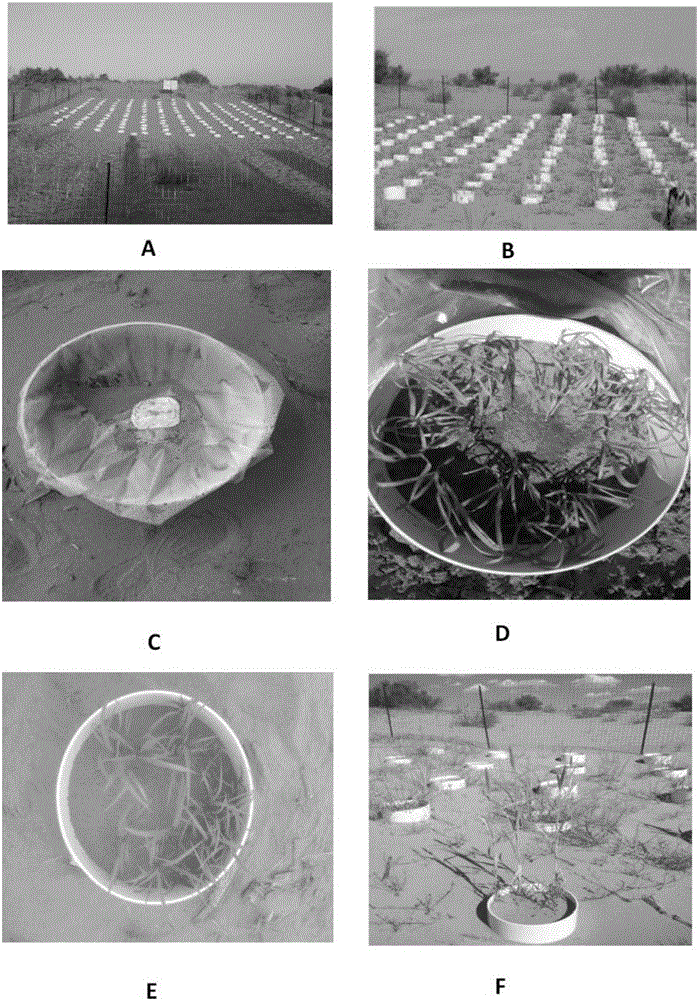Three-dimensional prevention and control method for desertification using biological soil crust-plant system
A biological soil and crust technology, applied in the construction of artificial biological soil crusts, can solve problems such as water shortage, reduce wind and water erosion, promote the restoration of ecological environment, and reduce the effects of wind and water erosion.
- Summary
- Abstract
- Description
- Claims
- Application Information
AI Technical Summary
Problems solved by technology
Method used
Image
Examples
Embodiment 1
[0032] Example 1: Isolation and identification of microorganisms
[0033] Weigh 5g of biological soil crusts collected from Inner Mongolia into a 100mL conical flask, add 45mL of sterile water, the dilution concentration at this time is 10-1, weigh 0.5mL of soil suspension with a concentration of 10-1 in 10mL of soil suspension. In a sterile centrifuge tube, mix well, at this time the concentration is 10-2, take samples in turn, and dilute to a concentration of 10 -5 , take 100 μL of the diluted soil suspension and place it in solid medium such as 1 / 2R2A, Ashby, and dephosphorization, spread it, and place it in a light incubator for cultivation. After obtaining the pure cultures of photosynthetic bacteria, nitrogen-fixing bacteria, phosphate-solubilizing bacteria and cyanobacteria, extract their DNA, and select primers
[0034] 27F: 5'-AGAGTTTGATCMTGGCTCAG-3', see SEQ ID NO: 1,
[0035] 1492R: 5'-GGTTACCTTGTTACGACTT-3', see SEQ ID NO: 2, its 16S rDNA was amplified by PCR, th...
Embodiment 2
[0036] Example 2: Preliminary analysis of microbial functional genes
[0037] Use pufM and nifH to verify whether it has the functions of utilizing light energy and nitrogen fixation, respectively. using primers
[0038] puf M_uni F: 5'-GGNAAYYTNTWYTAYAAYCCNTTYCA-3', see SEQ ID NO: 3,
[0039] pufM_uni R: 5′-YCCATNGTCCANCKCCARAA-3′, see SEQ ID NO: 4, amplify the pufM functional gene of the isolated microorganism; use primers
[0040] FGPH273: 5′-CTC CGG GCC RCC NGA YTC-3′
[0041] , see SEQ ID NO: 5,
[0042] pol R 5′-ATS GCC ATC ATY TCR CCG GA-3′
[0043] , see SEQ ID NO: 6,
[0044] pol F: 5'-TGC GAY CCS AAR GCB GAC TC-3', see SEQ ID NO: 7,
[0045] AQER: 5'-GAC GAT GTA GAT YTC CTG-3', see SEQ ID NO: 8, the isolated microorganism was subjected to amplification of the nifH functional gene.
Embodiment 3
[0046] Example 3: Screening of siderophore strains
[0047] CAS plate formula: CAS blue staining solution contains 1mmol / L CAS (chrome azure), 0.1mmol / L FeCl 3 , 4mmol / L cetyltrimethylamine bromide, 0.1% phosphate buffer at pH 6.8, 3g KH per 100mL MM9 salt solution 2 PO 4 , 5g NaCl, 10g NH 4 Cl.
[0048] CAS solid medium: Take 100mL MM9 salt solution in 750mL deionized water, dissolve 32.24g 2-2 sulfonic acid, pH is 6.8, add 15g agar, sterilize at high temperature and autoclave, cool to 50℃, add 30mL sterilized casein The hydrolyzate and 10 mL of 20% glucose were added to the MM9 / 2-2 sulfonic acid mixture, and 10 mL of CAS blue dye solution was slowly added until the substrate was mixed, and finally a solid plate was made. The activated strains were inoculated into the CAS solid medium by streaking, and the growth of the strains was observed during the period. The strains with orange halo were siderophore-producing strains. The experimental results showed that among the 5...
PUM
| Property | Measurement | Unit |
|---|---|---|
| Length | aaaaa | aaaaa |
| Particle size | aaaaa | aaaaa |
| Thickness | aaaaa | aaaaa |
Abstract
Description
Claims
Application Information
 Login to View More
Login to View More - R&D
- Intellectual Property
- Life Sciences
- Materials
- Tech Scout
- Unparalleled Data Quality
- Higher Quality Content
- 60% Fewer Hallucinations
Browse by: Latest US Patents, China's latest patents, Technical Efficacy Thesaurus, Application Domain, Technology Topic, Popular Technical Reports.
© 2025 PatSnap. All rights reserved.Legal|Privacy policy|Modern Slavery Act Transparency Statement|Sitemap|About US| Contact US: help@patsnap.com

